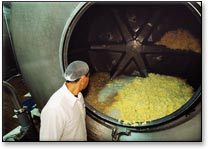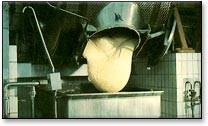our recipe for making butter yourself.) It is believed that the Nomads first discovered butter-making by mistake. They are said to have collected milk from cattle and goats, separated the cream from the milk, and continuously mixed the cream until it turned into butter.
Farm made butter uses the cream directly from whole milk whereas commercially made butter is made by extracting small amounts of cream from whey, a by-product of cheese-making, using large centrifuges.
Butter is essentially the fat of the milk. It is usually made from sweet cream and is salted. However, it can also be made from acidulated or bacteriologically soured cream and saltless (sweet) butters are also available. Well into the 19th century butter was still made from cream that had been allowed to stand and sour naturally. The cream was then skimmed from the top of the milk and poured into a wooden tub. Buttermaking was done by hand in butter churns. The natural souring process is, however, a very sensitive one and infection by foreign micro-organisms often spoiled the result. Today's commercial buttermaking is a product of the knowledge and experience gained over the years in such matters as hygiene, bacterial acidifying and heat treatment, as well as the rapid technical development that has led to the advanced machinery now used. The commercial cream separator was introduced at the end of the 19th century, the continuous churn had been commercialized by the middle of the 20th century.


